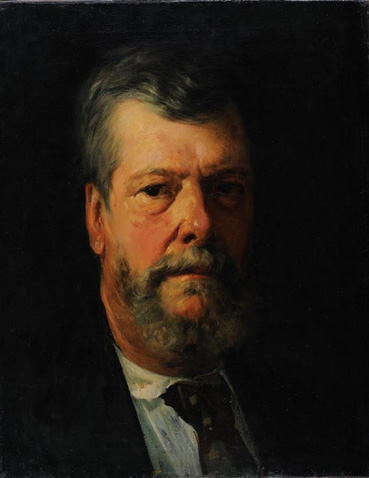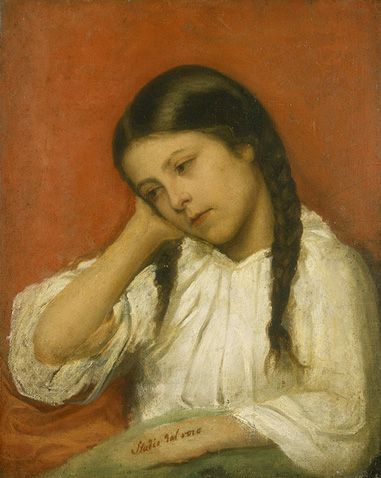At the time when the Bulgarian nation was suffering through the last decades of the Ottoman rule, a Bulgarian artist living abroad tasted freedom in advance. Dimitar Dobrovich managed to graduate from the university and take part at the national unification movements in Italy. He placed among Europe's most celebrated Romantic Painters. Although he spent most of his life in Rome, he returned to his liberated motherland and spent the last years of his life there.
 Dobrovich was born in 1816 in the city of Sliven (Southeast Bulgaria). He became an orphan when he was only eleven years old and shortly after that he departed to Istanbul (Tsarigrad) where he joined the Prahar Greek Orthodox College. His true artistic upsurge started in that city. Later his skills took him to other European capitals. His talent was acknowledged by several top European artists who encouraged him to develop in that field.
Dobrovich was born in 1816 in the city of Sliven (Southeast Bulgaria). He became an orphan when he was only eleven years old and shortly after that he departed to Istanbul (Tsarigrad) where he joined the Prahar Greek Orthodox College. His true artistic upsurge started in that city. Later his skills took him to other European capitals. His talent was acknowledged by several top European artists who encouraged him to develop in that field.
“Dimitar Dobrovich is an exceptional personality who laid the foundations of the Bulgarian secular art. He contributed a lot to his country's artistic life when he returned to Bulgaria and spent the last ten years of his life there”, art critic Associate Professor Ruzha Marinska told Radio Bulgaria. “Dimitar Dobrovich left his country as an adolescent. Initially, he studied in Istanbul and Athens and later he continued his studies in Rome, where he spent nearly 45 years of his life. Dobrovich can be related to the Late Italian Romanticism and is perhaps the only artist who can be conceptually attached to that movement of European art. We can find elements of Romanticism in his wonderful paintings of Italian Village Woman , as well as in his melancholic and sentimental female iportraits.”
No matter where he lived, however, the renowned Bulgarian artist could not forget the sad destiny of his motherland. Perhaps, that is why he joined Garibaldi's unification movement in Italy.
“When Dimitar Dobrovich arrived in Rome in November 1848, he found himself in the vortex of the biggest turmoil there”, Associate Professor Ruzha Marinska went on to say. “Being a young artist and already part of San Luka Academy of Fine Arts in Rome, Dimitar naturally joined the Italian revolutions of 1848. Later he confessed to Professor Ivan Shishmanov (a celebrated Bulgarian politician and intellectual), that he was part of the student's battalion for one moth only when he joined the barricades and defended the approach to Rome. It happened in May and June 1849. This was the time when he met with Giuseppe Garibaldi near Saint Giovanni Basilica in Rome.”
 Years later Dimitar Dobrovich returned to his liberated motherland- he was enthusiastic with the warm welcome of the Bulgarian delegation in Rome which was searching for an inheritor of the vacant throne which was previously occupied by Prince Alexander of Battenberg.Dobrovich received a warm welcome in his country. How much of his works reached Bulgaria though? More from Associate Professor Ruzha Marinska:
Years later Dimitar Dobrovich returned to his liberated motherland- he was enthusiastic with the warm welcome of the Bulgarian delegation in Rome which was searching for an inheritor of the vacant throne which was previously occupied by Prince Alexander of Battenberg.Dobrovich received a warm welcome in his country. How much of his works reached Bulgaria though? More from Associate Professor Ruzha Marinska:
“Dimitar Dobrovich was acknowledged in all countries he worked in. He received a series of awards and some of his works became part of Greek collections, but unfortunately we do not have access to them and did not have the opportunity to study them in details. The same thing happened with his works of art created in Rome. That is why we can only comment and analyze the works he brought to Bulgaria when he returned to his country back in 1893. Then, he displayed a hundred odd works at the National Assembly-both original works and replicas of Italian Renaissance artists. Today most of those paintings are kept at the National Art Gallery. However, a large collection is also on display at theSliven Art Gallery which was named after him in his honor. Many of his paintings became part of private collections. We tried to find some of his works painted during his stay in Rome and found out that some of them were sold at tenders and auctions under somebody else's name. That is why we must continue to work in that direction.”
2016 was dedicated to Dimitar Dobrovich. His 200th birth anniversary will be marked with scientific conferences, discussions and exhibitions which will present the extraordinary fate of that cosmopolitan personality.
English version: Kostadin Atanasov
A two-day festival of non-fiction books “Science, art and culture” is opening within the frameworks of the 51 st Sofia International Book Festival at the National Palace of Culture. Over the weekend, fans of history, art, cultural tourism and..
Plovdiv is hosting the annual festival for Bulgarian documentary and animation cinema ''Golden Rhyton'' which will last until December 19. The selection of movies is more than promising. More than 50 documentary and animated movies will compete in..
"In the book ‘Bulgaria I s M y S ong’ Iliya Lukov reveals himself to us as a great patriot who has done a lot for the Bulgarian spirit . " This is how Galin Georgiev, an ethnographer and one of the book's..

+359 2 9336 661
